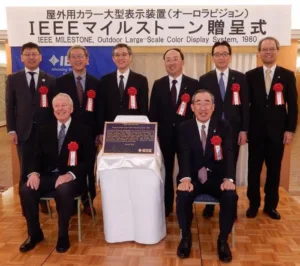Mitsubishi Electric Corporation (TOKYO: 6503) announced that the company’s Diamond Vision series of outdoor large-scale color display systems has received the prestigious IEEE Milestone award from the Institute of Electrical and Electronics Engineers (IEEE).
Diamond Vision is Mitsubishi Electric’s series of proprietary displays, of which more than 2,000 have been installed globally since the first unit was introduced at Dodger Stadium in Los Angeles, USA in 1980. The award recognises the prominent role as the world’s first outdoor large scale color display systems for creating impressive video images.

IEEE Milestone commemorative plaque
Up to 1980, electric scoreboards at stadiums conventionally only used incandescent lamps to project just letters and numbers. In response to growing demand for screens that could project images as beautiful as TV images at distances of up to 100 meters, Mitsubishi Electric successfully developed a three-color (red, blue and green) compact cathode ray tube (CRT) capable of displaying brilliant full-color video even in sunlight. Also, the company’s new software could be used to control images, music and other content, providing a tremendous boost to in-game entertainment at stadiums.
“We are deeply honored to receive the IEEE Milestone for Diamond Vision,” said Masaki Sakuyama, President and CEO of Mitsubishi Electric. “This is the first time our company has received this honor exclusively and it also represents the first IEEE Milestone to be received by a company in the Kyushu region of Japan. We are proud that Diamond Vision has continued to deliver highly impressive video images to spectators around the world for more than 35 years. We will continue to challenge ourselves to develop other useful technologies that truly enrich people’s lives.”
Presentation Ceremony at Hotel New Nagasaki on March 8, 2018
Since the first installation at Dodger Stadium, Diamond Vision displays have been adopted for use in a wide variety of facilities. Over time, Mitsubishi Electric’s engineering innovations have driven the evolution of light-emitting elements used in large displays, first by replacing single cathode ray tubes with flat matrix CRTs, and then replacing these CRTs with LEDs. Such changes further improved the video quality and led to the increasing use of Diamond Vision displays in diverse event facilities, not just sports stadiums. As such, Diamond Vision has played a profound role in delivering highly impressive video images to spectators around the world.
Major Diamond Vision Installations
More than 2,000 Diamond Vision displays have been installed in sports stadiums, racetracks, public spaces, shopping malls and other types of venues in Japan and abroad.
| Completed | Special Notes | Site | Screen Size (w) x (h) |
| July, 1980 | World’s first full color large-scale display device installed | Dodger Stadium (USA) | 8.7m x 5.8m |
| March,1981 | First installed in Japan | Korakuen Stadium (Japan) | 13.0m x 5.8m |
| August,1988 | Flat matrix type CRT installed | Kishiwada Cyclepia Stadium (Japan) | 5.12m x 4.16m |
| October, 1996 | Frist LED types installed | Iwataya Department Store (Japan) | 2.27m x 1.62m |
| April, 2003 | 3 in 1 LED types installed | Mitsubishi Motors Showroom (Japan) | 3.84m x 2.88m |
| March, 2014 | Black package LED installed | Studio Alta (Japan) | 12.8m x 7.2m |
| August, 2003 | (Then) World’s longest screen installed | Sha Tin Racecourse (Hong Kong) | 70.4m x 8.0m |
| March, 2005 | World’s biggest outdoor HD video screen installed | Atlanta Braves (USA) | 24.0m x 21.7m |
| September, 2009 | (Then) World’s biggest full HD video screen | Dallas Cowboys (USA) |
48.32m x 21.76m x 2sets 15.36m x 8.7m x 2sets 601.92m x 1.056m 253.1m x 0.88m x 2sets 10.9m x 2.3m x 4sets |
| January, 2010 | (Then) World’s longest video screen | UAE Madan horse race course (UAE) | 107.5m x 10.88m |
| November, 2014 | (Then) World’s biggest video screen for advertisement | 1535 Broadway Marriot Marquis (USA) | 100.4m x 23.6m |

